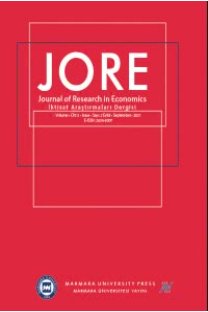THE EFFECTS OF ENERGETIC TRANSITION ON ECONOMIC GROWTH IN IRAN
In this paper, we study the effects of renewable energy consumption on economic growth in Iran in the period 1983 to 2013, through Autoregressive Distributed Lag (ARDL) method. Results show that an increase in renewable energy consumption increases economic growth. In other words, there is a positive and statistically significant relationship between renewable energy consumption and economic growth. The results show that in the long-run 1% increase in consumption of renewable energy leads to 4.06% increase in economic growth; they also show that in a short-run, 1% increase in it also can lead to 7.5% increase in economic growth.
Anahtar Kelimeler:
Renewable Energy Consumption, Economic Growth, Autoregressive Distributed Lag Method
___
- Akinlo, A. (2008). Energy consumption on economic growth: evidence from 11 Sub-Sahara African countries. Energy Economics, 30: 2391-2400.
- Apergis, N. and Payne, J. E. (2010A). Renewable Energy Consumption and growth in Euro-Asia, Energy Economics, 32:1392-1397.
- Apergis, N. and Payne, J. E. (2010 B). Renewable Energy Consumption – growth Nexus: evidence from a panel error correction model, Energy Economics, 88: 5226-5230.
- Ayres, R.U., Turton, H. and Casten, T. (2007). Energy efficiency, sustainability and economic growth. Energy Economics, 32: 634-648.
- Banerjee, A., Dolado, J. J. and Mestre, R. (1992). On some simple tests for cointegration: The cost of simplicity. Ed. Banco de España. Banco de España. Servicio de Estudios.
- Fang, Y. (2011). Economic welfare impact from renewable energy consumption: The China experience, Renewable and sustainable energy Reviews, 15: 5120-5128.
- Fuinhas, J.A. and Marques, A.C. (2012). Energy consumption and economic growth nexus in Portugal, Italy, Greece, Spain and Turkey: an ARDL bounds test approach (1965-2009). Energy economics, 34: 511-517.
- IMF (International Monetary Fund) (2015), World Economic Outlook - Update January 2015, IMF, Washington, DC.
- IPCC (Intergovernmental Panel on Climate Change) (2014), Climate Change 2014: Synthesis Report: Contribution of Working Group I, II and III to the Fifth Assessment Report of the Intergovernmental Panel on Climate Change, IPCC, Geneva.
- Lee, C.C. (2006). The causality relationship between energy consumption and GDP in G-11 countries revisited. Energy policy, 34: 1086-1093.
- Lee, C.C. and Chang, C.P. (2007). The impact of energy consumption on economic growth: evidence from linear and nonlinear models in Taiwan. Energy Economics, 32: 2282-2294.
- Menegaki, A. N. (2011). Growth and Renewable in Europe: A random effect model with evidence for neutrality hypothesis, Energy Economics, 3: 57-63.
- Noferesti, M. (1999). Unit Root and Cointegration in Econometrics. Tehran, Rasa cultural Services Institute, (in Persian).
- Oh, W. and Lee, K. (2004), Casual relationship between energy consumption and GDP Revisited: The case of Korea 1970-1999, Energy Economics, 26(8): 973-981.
- Payne, J.E. (2010). Survey of the international evidence on the causal relationship between energy consumption and growth. Journal of Economic studies, 37: 53-95.
- Pesaran, M.H. and Shin, Y. (1998). An autoregressive distributed-lag modelling approach to cointegration analysis. Econometric Society Monographs, 31: 371-413.
- Pesaran, M.H and Shin Y. (1997). An Autoregressive Distributed Lag Modeling approach to cointegration analysis. Department of Applied Economics, University of Cambridge, England.
- Pesaran, M.H, Shin, Y. and Smith, R.J. (1996). Testing for existence of long run relationship. DAE working papers Amalgamated series. 9622. University of Cambridge.
- Stern, D.I. (1993). Energy and economic growth in the USA. Energy Economics, 15: 137-150.
- Stern, D.I. (2000). Multivariate cointegration analysis of the role of energy in the US macroeconomy. Energy Economics, 22: 267-283.
- Wolde-Rufael, Y. (2009). Energy Consumption and economic growth: The experience of African Countries revisited. Energy Economics, 31: 217—224.
- ISSN: 2636-8307
- Başlangıç: 2016
- Yayıncı: Marmara Üniversitesi
Sayıdaki Diğer Makaleler
DÜNYADA VE TÜRKİYE’DE SERBEST BÖLGELER
Sevil ACAR, Derya GÜLTEKİN-KARAKAŞ
TÜRKİYE’NİN 1990-2015 DÖNEMİNDEKİ EKONOMİK PERFORMANSI ÜZERİNE BİR DEĞERLENDİRME
THE EFFECTS OF ENERGETIC TRANSITION ON ECONOMIC GROWTH IN IRAN
Nathalie HILMI, Alain SAFA, Shekoofeh FARAHMAND, Majid SAMETI, Salahaldin SASSAN
PLANLI DÖNEMDE KIRSAL KALKINMA BAĞLAMINDA BİR GİRİŞİM: TÜRKİYE SÜT ENDÜSTRİSİ KURUMU (1963-1995)
DISTRIBUTIONAL DYNAMICS OF REGIONAL INCOMES IN TURKEY: 1987-2014
